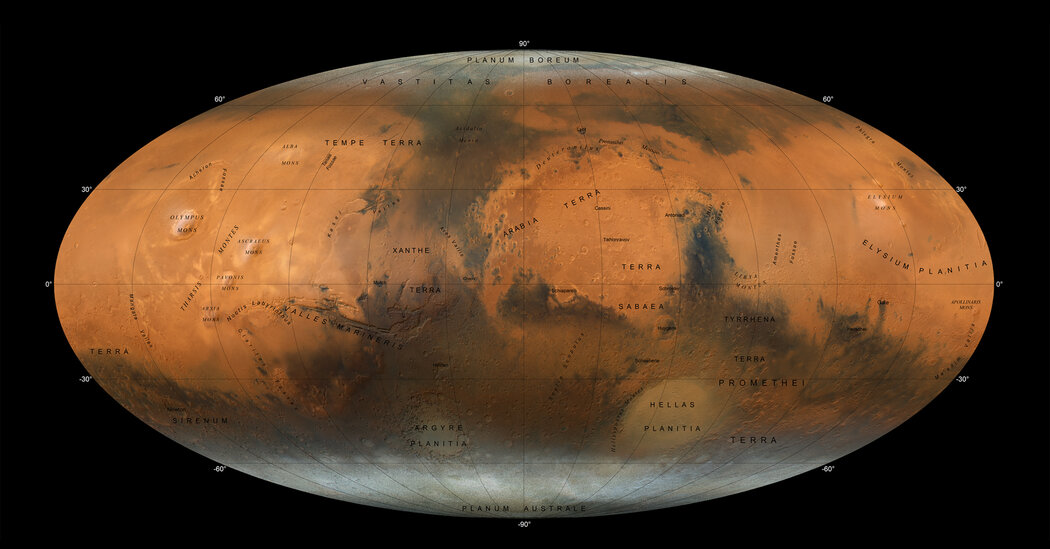Arizona, Low on Water, Weighs Taking It From the Sea. In Mexico.
Fifty miles south of the U.S. border, at the edge of a city on the Gulf of California, a few acres of dusty shrubs could determine the future of Arizona.
As the state’s two major sources of water, groundwater and the Colorado River, dwindle from drought, climate change and overuse, officials are considering a hydrological Hail Mary: the construction of a plant in Mexico to suck salt out of seawater, then pipe that water hundreds of miles, much of it uphill, to Phoenix.
The idea of building a desalination plant in Mexico has been discussed in Arizona for years. But now, a $5 billion project proposed by an Israeli company is under serious consideration, an indication of how worries about water shortages are rattling policymakers in Arizona and across the American West.
On June 1, the state announced that the Phoenix area, the fastest-growing region in the country, doesn’t have enough groundwater to support all the future housing that has already been approved. Cities and developers that want to build additional projects beyond what has already been allowed would have to find new sources of water.
State officials are considering whether to set aside an initial $750 million toward the cost of the desalination project, although Gov. Katie Hobbs, a Democrat, has yet to endorse it.
“Desal in Mexico is a highly likely outcome for Arizona,” said Chuck Podolak, the state official in charge of finding new sources of water. Last year, lawmakers agreed to give his agency, the Water Infrastructure Finance Authority of Arizona, $1 billion toward that mission. He said whatever water project gets built “will seem crazy and ambitious — until it’s complete. And that’s our history in Arizona.”
Desalination plants are already common in coastal states like California, Texas and Florida, and in more than 100 other countries. Israel gets more than 60 percent of its drinking water from the Mediterranean.
The Arizona project would be unusual because of the distance involved and the fact that the state is landlocked. The water would have to travel some 200 miles, climbing more than 2,000 feet along the way, to reach Phoenix.
“We live in a world with gravity,” said Meagan Mauter, an associate professor of civil and environmental engineering at Stanford University and an expert on desalination. “The minute you have to move water around, you have huge fixed costs.”
The plant would allow Arizona to continue growing — but at a high cost.
It would flood the northern Gulf of California with waste brine, threatening one of Mexico’s most productive fisheries. It would carve a freeway-sized corridor through a U.S. national monument and UNESCO site, established to protect a fragile desert ecosystem. And the water it provided would cost roughly ten times more than water from the Colorado River.
In a sense, Arizona has been here before. The state owes its boom to superhuman-scale water projects, culminating in the 336-mile, $4 billion aqueduct that diverts Colorado River water to Phoenix and Tucson. IDE Technologies, the Israeli company behind the new desalination proposal, has seized on that legacy, calling its project “an infinite and unlimited reverse Colorado.”
That message has found an audience. According to IDE, even before the announcement of a groundwater shortage, representatives from Phoenix and a half-dozen cities around it met with the company to learn about the project.
Environmentalists contend that instead of importing water from another country, the state should protect its limited supplies by having fewer lawns, fewer swimming pools and, maybe, fewer houses.
“What Arizona really needs to do is implement stronger water conservation,” said Miché Lozano, who until recently was Arizona program manager for the National Parks Conservation Association. “The pipeline is just such a big, dumb idea.”
A nightmare version of Arizona’s future
The proposed source of Arizona’s salvation is Puerto Peñasco, a city of 60,000 an hour south of the border. From the ocean, the city is a ribbon of luxury villas and high-rise condos, fronted by soft beaches unfurling into turquoise water. Tourists from Phoenix, who make up the bulk of visitors, call it by its Anglicized name, Rocky Point; its unofficial moniker is Arizona’s beach.
But behind the glamour is a city of unpaved roads and low cinder block structures, covered in dust and sand blown in from the desert around it. A third of the population lives in poverty. Among its other problems: Puerto Peñasco can’t provide enough potable water for its own residents.
The city is a nightmare version of Arizona’s own future. Lacking surface water, it relies on underground aquifers, whose supply has dwindled as the population has grown. When tourism swells in summer, water pressure in the pipes drops; residents must rely on whatever they’ve managed to store in cisterns.
The Israeli company has said it would provide Puerto Peñasco with some potable water as part of its proposal, though not how much or at what price. The head of the local water provider, Héctor Acosta Félix, said some sort of desalination project is vital for Puerto Peñasco’s future.
But one part of the plan poses a challenge: what to do with waste.
Desalination works by vacuuming up huge volumes of ocean water, then pushing it at high pressure through a series of membranes to filter out salt. Every 100 gallons of seawater produces about 50 gallons of potable water and another 50 gallons of brine that has a salt content that is roughly twice as high as seawater.
IDE would release that brine into the sea. On the open ocean, waste brine can be quickly dispersed. But because Puerto Peñasco is near the tip of the Gulf of California, effectively a long and shallow bay, the effects could be concentrated.
That could hurt the plankton that forms the base of the food chain, said Nélida Barajas Acosta, head of an environmental group called CEDO Intercultural. More than half of the fishing in Mexico is harvested from the Gulf of California.
“The effects on fisheries will be dramatic,” Ms. Acosta said. “The water is going into the U.S., but the environmental impacts stay in Mexico.”
IDE, one of the world’s largest desalination companies, declined to comment for this story. But in public meetings with Arizona officials in December, company representatives dismissed concerns.
The company asked Arizona to sign a 100-year contract to buy water from the desalination project. In return, IDE says it would find private financing to cover the estimated $5 billion initial cost of building the desalination plant and pipeline. The company has been working with Goldman Sachs to arrange that financing. Goldman Sachs did not respond to a request for comment.
Erez Hoter-Ishay, IDE’s project manager, said the discharge of brine wouldn’t harm ocean life, and suggested it might even be beneficial. “We see in other desal facilities that life are flourishing next to it,” he told lawmakers.
It’s unclear whether Mexican officials would support the plan. The governor of Sonora, Alfonso Durazo, has said he opposes it. But the national government has jurisdiction over water in Mexico, and President Andrés Manuel López Obrador was quoted in January saying he was open to the idea.
Mr. Durazo’s office did not respond to a request for comment. Mr. López Obrador’s office referred questions to the National Water Commission, which did not respond.
Cutting through a biosphere reserve
Getting Mexican approval might not be the biggest hurdle.
Between Puerto Peñasco and Phoenix sits one of the most ecologically fragile places in Arizona: Organ Pipe Cactus National Monument, a riot of velvet mesquite, teddy-bear cholla and red-flower-tipped ocotillo, teeming with roadrunners and rattlesnakes and giant-eared jackrabbits, spilling across 500 square miles at the state’s southern edge like an overstuffed psychedelic fever dream.
UNESCO has declared the monument, along with a national park on Mexico’s side of the border, a biosphere reserve — a distinction bestowed almost nowhere else in the Southwest United States. The pipeline would cut through the middle of it.
And not just the pipeline. Desalination plants require a tremendous amount of energy. To power the plant, IDE would build one of America’s largest solar farms near Phoenix, plus a transmission line to move that power to Mexico. That line would need a 150-foot-wide right of way corridor, a project consultant told officials in December. The water pipeline would require a 175-foot corridor.
The U.S. Bureau of Land Management is reviewing an application from IDE to construct those lines through the park.
“We’re bypassing the wilderness areas,” Mr. Hoter-Ishay told lawmakers. He did not explain what that meant or how it would be accomplished.
In addition to its ecological value, the land has spiritual significance for the Tohono O’odham Nation, whose people lived there for thousands of years before being displaced to a reservation east of the park.
On a recent morning, Lorraine Eiler, a tribal representative, wandered an area of the park where her ancestors had lived. Endangered mud turtles and pupfish drifted through a spring-fed pond; the branches of wolfberry shrubs sagged with orange-red fruit the size of jelly beans. Saguaro cactuses rose overhead, their stubby arms thrust upward like startled giants.
Ms. Eiler said the O’odham believe that each saguaro embodies a human spirit. The pipeline would require ripping out countless saguaros. “When you knock one down, it’s like knocking you down,” she said.
She was joined among the saguaros by Mr. Lozano, who was more blunt.
“A private foreign company coming in and doing a binational pipeline through two UNESCO biosphere reserves with endangered species everywhere just doesn’t seem like a great idea,” Mr. Lozano said. “That’s just me.”
‘Crazy and ambitious’
Ninety miles north of Organ Pipe, land was being readied for construction in Buckeye, an outer suburb of Phoenix. Since 2010, the city’s population has doubled, to more than 100,000; officials say it could eventually reach one million.
Those residents will need water — and Buckeye’s options are dwindling. In January, Arizona’s water department said there wasn’t enough groundwater beneath Buckeye to support new homes beyond the construction that has already been approved.
IDE’s pipeline, which would run past the city, is fundamentally an offer to keep places like Buckeye viable. Terry Lowe, the city’s water resources director, said the cost of that water was probably too high for now. But as Buckeye keeps growing, he expects that could change.
“The deal with water in Arizona is not how much water there is,” Mr. Lowe said. “It’s how much do we want to pay for it.”
Arizona is Buckeye writ large. Since the megadrought began in 2000, Arizona’s population has jumped almost 50 percent and shows no signs of stopping.
So far, IDE’s proposal is the only formal offer submitted to the state agency trying to secure more water. While no decision has been made and Mr. Podolak says he wants other proposals, he said some version of the plan will probably happen eventually.
In the sprawling metropolis outside his office, the homes kept going up.
Steve Fisher contributed reporting from Mexico City.


